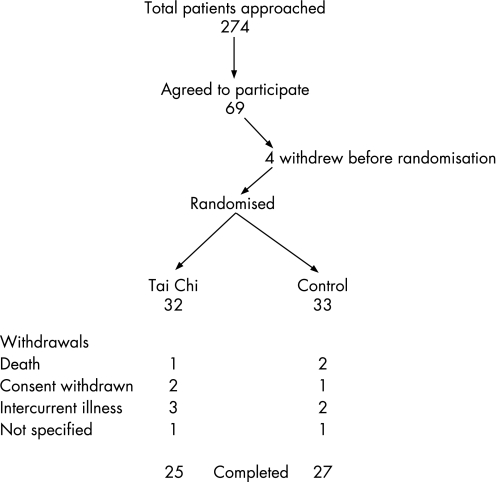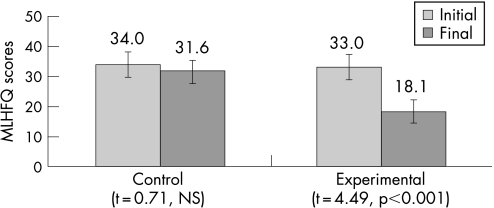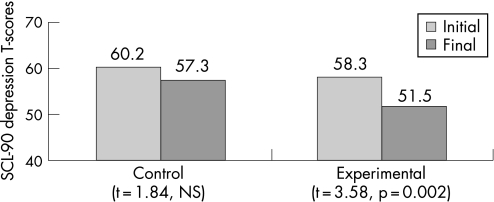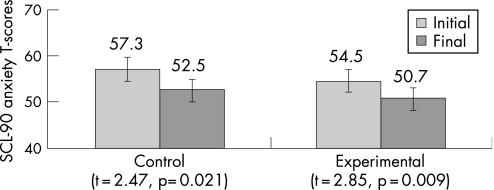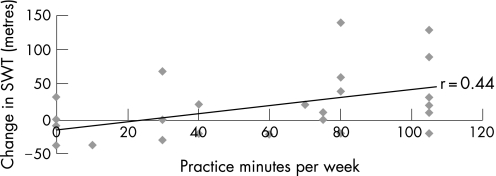Abstract
Objective
To study the effect of Tai Chi on exercise tolerance in patients with moderate heart failure.
Design
Randomised parallel group study balanced for baseline variables.
Setting
Cardiology Department, Royal Hallamshire Hospital.
Patients and methods
52 patients (42 men, mean age (68.9 years), range (46–90 years), and 10 women, mean age (70.0 years), range (58–82)) with chronic heart failure (New York Heart Association symptom class II–III) were studied. Patients were randomised to Tai Chi Chuan twice a week for 16 weeks or to standard medical care without exercise rehabilitation.
Main outcome measures
The primary outcome measure was the change in the distance walked in the shuttle walk test. Secondary outcome measures were changes in symptom scores and quality of life indices.
Results
Objective measures of exercise tolerance did not improve significantly with Tai Chi, but patients having Tai Chi exercise had an improvement in symptom scores of heart failure measured by the Minnesota Living with Heart Failure Questionnaire (comparison of deltas, −2.4 control vs −14.9; p = 0.01), and depression scores measured by the SCL‐90‐R questionnaire (−2.9 vs −6.8; p = 0.12) compared with those patients in the control group.
Conclusion
In patients with chronic heart failure, 16 weeks of Tai Chi training was safe, with no adverse exercise related problems. It was enjoyed by all taking part and led to significant improvements in symptoms and quality of life.
Keywords: heart failure, exercise, shuttle walk test, Tai chi
Heart failure is a chronic disease that affects daily living, exercise tolerance and quality of life. It has a prognosis comparable to the worst forms of cancer, requiring frequent hospital admissions.1 Patients with heart failure are often excluded from cardiac rehabilitation programmes because of the fear of exercise related adverse events.2 However, studies of moderate to high exercise using bicycle ergometry have produced beneficial effects on skeletal muscle aerobic capacity, increased exercise tolerance and quality of life, and reduced dyspnoea.3,4,5 The majority of these studies were over a short period of weeks, and doubts have been raised as to the long term suitability of moderate to high intensity exercise, given the progressive decline in health status of these patients.6,7 Lower intensity exercise appears to be as effective as that of moderate to high intensity in the long term, in improving skeletal muscle function, aerobic capacity, autonomic function and quality of life.8 In long term rehabilitation programmes for heart failure, lower intensity exercise may produce less ventricular wall stress and reduce the risk of malignant arrhythmias.9,10
An alternative to current low intensity exercise recommendation could be Tai Chi Chuan, a Chinese martial art. The movement characteristics of slowness, quietness and stillness inherent in Tai Chi could provide an answer to the limitations of standard exercise programmes for patients with heart failure. Tai Chi Chuan is an ancient Chinese martial art that is used by millions of Chinese as a health exercise to maintain suppleness and mobility. It is well suited to the aged and requires only low to moderate intensity; its steady rhythm and slow movements aid relaxation and promote a feeling of well being.11 Reported benefits of Tai Chi practice include improvements in cardiopulmonary function.12,13,14 Other studies of Tai Chi in patients with heart failure15,16 have shown some improvements in quality of life, symptoms and exercise tolerance.
In this trial we randomised patents with heart failure to normal clinical care without formal exercise rehabilitation, or to Tai Chi Chuan practice, and studied the effects on exercise tolerance, heart failure symptoms and quality of life.
Patients and methods
The study was approved by the South Yorkshire Ethics Committee and funded by a grant from the British Heart Foundation. All patients gave written informed consent
Patients
Patients were included if they had stable symptomatic chronic heart failure for at least 3 months, with evidence on echocardiography of left ventricular systolic dysfunction. Patients were excluded if they had symptomatic postural hypotension, sustained ventricular arrhythmias, hypertension (defined by persistent systolic blood pressure of 180 mm Hg or diastolic blood pressure >110 mm Hg), severe obstructive valvular disease or other respiratory of locomotor condition that would otherwise limit their exercise capacity.
Sixty‐nine of 274 outpatients who were initially approached agreed to participate. Of these 69 patients, four dropped out before randomisation, so 65 were randomised in the study. All were in New York Heart Association (NYHA) symptom class II–III. Patients were recruited in three cohorts of 20, 24, and 21, respectively, of whom 13 were lost to follow up (fig 1). Fifty‐two patients (25 experimental, 27 control) completed the trial. Patients were matched in pairs for baseline measures, then each pair randomly allocated to treatment or control. Given the need to train individuals in Tai Chi, it was necessary to ensure that the experimental (exp) group size did not exceed 10; the study was therefore performed in three consecutive groups each lasting 16 weeks. Group 1 included 15 patients (exp 7, control 8), group 2, 19 patients (exp 10, control 9), and group 3, 18 patients (8 exp, 10 control), respectively. Overall there were 42 men (mean age 68.9 years, range 46–90 years) and 10 women (mean age 70.0 years, range 58–82 years).
Figure 1 Flow diagram of study recruitment.
Measures
Exercise capacity was assessed using the incremental shuttle walk test (ISWT). Two tests were performed at the start and at the end of the 16 week period. The average of the two tests was used in the analysis. The ISWT is a symptom limited exercise test with a progressive increase in workload designed to allow subjects to achieve maximum effort tolerance. Subjects walk back and forth along a horizontal 10 m course, marked out by two cones, and must complete the shuttle before a pre‐recorded signal from a cassette player, which shortens incrementally after each shuttle. The end point (distance walked in metres) is reached when the subject fails to complete the shuttle before the signal. The ISWT has been evaluated in patients with chronic heart failure, as an alternative to cardiopulmonary exercise testing and the traditional 6 min walk test. It is highly reproducible, preferred by patients, and correlates strongly with peak oxygen consumption (V̇o2) (r = 0.84, p<0.0001). In multivariate analysis the ISWT was found to be the most significant independent predictor of peak V̇o217,18 and, after 17 months follow up, predicted event‐free survival, whereas the 6 min walk test did not.19
Subjects completed the Minnesota Living with Heart Failure questionnaire (MLHF) to assess disease specific symptoms and quality of life, and the SCL‐R questionnaire to give a standardised assessment of mood at the beginning and end of the treatment period. Systolic and diastolic blood pressure was measured at the beginning and end of the treatment period.
Intervention group
The experimental group received two 55 min sessions of Tai Chi exercise per week for 16 weeks. The sessions were carried out every Monday and Friday of each week and the patients were encouraged to practice what they had learnt at home and to record the length of personal practice time. Each session began with 20 min of Chi Kung exercises (including an explanation of the exercise principles involved), followed by a 5 min rest period. The session recommenced with Tai Chi Chuan practice for 20 min followed by 5 min of cooling down stretching exercises. The Tai Chi exercises were designed around the Tai Chi and Chi Kung exercises to achieve the following:
work the lower limbs, positively affecting muscular tone
work rate was set at a moderate level as assessed by reference to the Borg Scale for patient self assessment
relaxation/meditation methods were used to promote relaxation effects to encourage positive autonomic responses
upper body (arm, shoulder and chest) exercises to improve tone in the muscles used in respiration.
Chi Kung is a series of exercises that complement Tai Chi practice and are commonly used while learning Tai Chi as an introductory warm up. These exercises purport to produce relaxation, stillness of mind and of mood. The Tai Chi Chuan employed in this study was the Wu Chian Chuan style as practised by the Ma family in Shanghai China. The Chi Kung exercises were derived from the Orchid Hand 21 Style and Wu's Chi Kung exercises.
Exercises were conducted by a trained Tai Chi trainer with a trained cardiac rehabilitation nurse also in attendance. The exercise programme was graded and gradually increased, reaching full potential on the eighth week. This was because Tai Chi is initially difficult to learn so it was necessary to gradually increase the forms and to allow the patients to become accustomed to the exercises, in order to minimise adverse reactions.
Control group
The control group received standard medical supervision and drug treatment. This comprised regular contact with specialist heart failure nurses and outpatient visits with medical staff every 3 months. Patients were not told to restrict activities but were not told to do extra exercise. In addition, they were told that they could contact a member of the research staff if any problems or queries arose during the trial.
Statistical analysis
A pilot study of four patients was carried out to test the acceptability of the intervention in patients with heart failure and to provide information on statistical power. A mean improvement of 18% in shuttle walk distance was observed from baseline, and the data showed that 25 patients in each group would have a power of 75% to identify a similar change in trial subjects.
In order to avoid large differences in baseline measures between the groups by chance, a Monte Carlo procedure was used to maximise similarities between pairs of subjects, selecting the best fit after the baseline measures were completed. The patients were matched in pairs for age, gender, systolic blood pressure (SBP) and diastolic blood pressure (DBP), NYHA rating, brain natriuretic peptide (BNP) concentration, shuttle walk test, SCL‐90‐R depression and anxiety scores, and Minnesota LWHF symptom scores; each member was then randomly allocated to either treatment or control. In the third cohort, where there was an odd number of recruits, the individual closest to the overall group mean was identified and separately randomised to treatment or control (table 1).
Table 1 Baseline matched data for each group (includes those lost to follow up).
| Variable | Experimental n = 32 | Control n = 33 | Statistical significance |
|---|---|---|---|
| Male/female | 26/6 | 27/6 | NS |
| Mean age (in years) | 68.4 | 67.9 | NS |
| Systolic blood pressure (mean) | 125.3 | 129.0 | NS |
| Diastolic blood pressure (mean) | 74.5 | 76.8 | NS |
| ISWD (average of 2) (metres) | 194 | 194 | NS |
| Brain natriuretic peptide (pg/l) | 235 | 239 | NS |
| MLHF score | 35.1 | 34.9 | NS |
| SCL‐R anxiety score | 55.2 | 57.1 | NS |
| SCL‐R depression score | 59.5 | 60.5 | NS |
ISWD, incremental shuttle walk test; MLHF, Minnesota Living with Heart Failure symptom score.
No change was seen in the systolic or diastolic blood pressures.
There was one objective and two subjective end points. The primary end point for the study was the change in the average (of two) shuttle walk distances after Tai Chi compared with the change in the control group. The secondary end points were changes in symptom scores of heart failure and mood. We had intended also to measure changes in BNP between the groups, but because of technical problems we were unable to complete the post‐intervention assays.
The primary outcome measure was the change in shuttle walk test distance with Tai Chi compared with the change after no intervention (that is, a comparison of the deltas). This change was compared using paired Student's t tests.
Results
Subjective variables
Changes in perceived symptoms
Both groups showed reductions in the perceived symptoms of heart failure. However, there was a significant reduction in symptoms only in the Tai Chi group (fig 2). Comparison of the change from baseline in the two groups showed a significant effect of Tai Chi (−2.4 control vs −14.9 Tai Chi; p = 0.001) (table 2).
Figure 2 Change in symptoms on the Minnesota Living with Heart Failure (MLHF) questionnaire in the two groups.
Table 2 Summary of results.
| Control | Experimental | |||||||||
|---|---|---|---|---|---|---|---|---|---|---|
| Initial | Final | Change | t Value | p Value | Initial | Final | Change | t value | p Value | |
| SBP | 132 | 124 | −8 | 1.64 | 0.11 | 125 | 123 | −2 | 0.81 | 0.43 |
| DBP | 78 | 71 | −7 | 2.02 | 0.054 | 75 | 71 | −4 | 1.96 | 0.062 |
| ISWT min | 177 | 187 | 10 | 0.66 | 0.51 | 169 | 189 | 20 | 2.06 | 0.05 |
| ISWT max | 209 | 209 | 0 | 0.05 | 0.96 | 210 | 218 | 8.0 | 0.88 | 0.39 |
| ISWT mean | 193 | 198 | 5 | NS | 190 | 204 | 14 | NS | ||
| MLHFQ | 34.0 | 31.6 | −2.4 | 0.71 | 0.48 | 33.0 | 18.1 | −14.9 | 4.49 | 0.001 |
| SCL‐90 Anx | 57.3 | 52.5 | −4.8 | 2.47 | 0.021 | 54.5 | 50.7 | −3.8 | 2.85 | 0.009 |
| SCL‐90 Dept | 60.2 | 57.3 | −2.9 | 1.84 | 0.078 | 58.3 | 51.5 | −6.8 | 3.58 | 0.002 |
DBP, diastolic blood pressure; ISWD, incremental shuttle walk test; MLHF, Minnesota Living with Heart Failure symptom score; SBP, systolic blood pressure.
Psychological changes
The SCL‐90‐R depression scale showed significant reductions in the experimental group (p = 0.002), but no significant changes in the control group (fig 3). However, comparison between the groups did not reach statistical significance (−2.9 control vs −6.8 Tai Chi; p = 0.12). Both experimental and control groups showed a significant reduction in the SCL‐90‐R anxiety scores over the course of the study (fig 4), but there was no difference between the groups.
Figure 3 Change in the mood scores on the SCL‐R depression index in the two groups.
Figure 4 Change in the mood scores on the SCL‐R anxiety index in the two groups.
Objective variables
Incremental shuttle walk test
There was a significant increase in the minimal ISWT distance in the experimental but not the control group (table 2). There was no change in the primary end point of the mean distance walked on the incremental shuttle walk test between the two groups (+5 m control vs +14 m; p = NS).
There was a positive correlation between practice time between sessions and the minimum ISWD (r = 0.44, p = 0.05) (fig 5). No significant correlation was found between practice and mean shuttle walk distance (r = 0.34; p = 0.09). Those subjects who practised for more than 1 h per week had a better chance of showing improvements in walking distance over the experimental period (Fisher test, p = 0.015) (table 3).
Figure 5 Correlation between minimum distance walked and personal practice time. SWT, shuttle walk test.
Table 3 Association between practice times and improvement/decline.
| Practice <1 h/week | Practice >1 h/week | |
|---|---|---|
| No change or decline | 8 | 3 |
| Improvement | 3 | 11 |
Drug treatment
Patients remained under the care of their usual physicians during the course of the study, and drug treatments were modified at the discretion of the treating physician. In the control group, four patients had changes to their vasoactive medication. One patient had the dose of angiotensin converting enzyme inhibitor (ramipril) increased from 1.25 mg twice daily to 5 mg twice daily, and one patient had the dose decreased from 10 mg to 5 mg and in one case stopped (1.25 mg twice daily). The dose of doxazosin (a vasodilator) was increased from 1 mg once daily to 4 mg once daily in another patient. In the Tai Chi group four patients had changes to vasoactive medication—in two patients diuretic dosages were increased (20 mg furosemide daily to 40 mg in one patient, and in another patient spironolactone 25 mg was increased to 50 mg, and furosemide 80 mg was increased to 120 mg daily). In one patient the dose of amlodipine (a calcium channel blocker) was increased from 5 mg daily to 10 mg, and in another patient enalapril 10 mg twice daily was stopped and doxazosin was started instead (2 mg daily).
Adverse effects
No adverse effects occurred in the Tai Chi sessions. During the study, one patient in the intervention group and one in the control group withdrew due to worsening heart failure symptoms. Two patients in the control group withdrew because of worsening co‐morbidities. One patient died in the intervention group and two died in the control.
Discussion
In patients having Tai Chi there was a significant improvement in symptoms of heart failure and improvement in psychological well being. There was no significant change in the mean ISWT distance walked. Smart et al19 showed that different intensity of exercise resulted in different benefits in patients with heart failure; low intensity aerobic exercise was associated with a maximum increase of 17% in exercise capacity, and high intensity exercise (70–80% peak capacity), a 23% improvement in functional capacity. In this study we recorded about a 7% increase in the mean SWT distance in the Tai Chi group. A recent study by Yeh et al,16 investigating Tai Chi in heart failure, reported a 26% increase in mean distance walked during the 6 min walk test. As Tai Chi is a complex exercise routine that requires considerable practice to become proficient, we believe it is possible that the small improvement shown in walking distance would increase over time. The significant correlation with practice time supports this.
What is already known?
Regular exercise improves symptoms in patients with chronic heart failure but the effects dissolve quickly once exercise stops.
Uptake in exercise programmes in this group of patients is low.
Tai Chi Chuan is a form of exercise used in China by millions for health benefit.
Learning points from this study
In this pilot study Tai Chi Chuan training was associated with improvements in self‐reported symptoms in patients with chronic heart failure.
Objective measures of exercise tolerance did not significantly change.
With the MLHF questionnaire, which quantifies perceived physical disability on a six point response scale, it has been shown that a score change of >7 is indicative of positive functional change.20 We reported a 15 point change in the experimental group only (p⩽0.001); this change was similar to the 17 point change reported in the study by Yeh et al.16 In our study the perceived positive effects provoked demands from the patients to continue the Tai Chi exercises upon completion of the trial. Tai Chi was well tolerated and enjoyed by all those taking part.
The positive change in perceived disability was reflected in the depression and anxiety scores of the SCL‐90‐R, and these scores compare favourably with depression and anxiety scores recorded for other studies in exercise rehabilitation.21 Scores on the SCL‐90‐R depression scale significantly improved only in the experimental group. Both groups showed significant reductions in the anxiety dimension scores, more so in the experimental group.
Limitations
This was a small pilot study over only 3 months, therefore conclusions about the acceptability of this form of exercise over longer periods cannot be drawn. The lack of objective benefit from Tai Chi in either measured exercise tolerance or BNP (for technical reasons) is disappointing, but we would hope that a larger study over a longer period of time would definitively answer this question. Our data support the notion that the more often the exercise is performed the more improvement is provided. In this pilot study we were not able to identify any change in hospitalisation or mortality rates between the groups. The control group did not have additional contact with study personnel over and above normal care in our service (heart failure nurse support and medical outpatient clinics). We cannot exclude the possibility that the symptomatic changes we have identified relate to the social contact with the Tai Chi trainer and nurse observer rather than from the effects of Tai Chi.
Conclusion and recommendations
During the 16 weeks of Tai Chi training, no exercise related problems occurred. This style of Tai Chi appears to be safe and was enjoyed by all taking part. Significant improvements in perceived symptoms and quality of life were recorded but not definite improvement in objective measures of effort tolerance. Because of these significant improvements Tai Chi could be a valuable alternative to both the high and low intensity aerobic exercise regimens recommended for heart failure. By the nature of the movement involved, it is possible for patients to perform Tai Chi despite limitations imposed by other co‐morbidities associated with age. Tai Chi is a group activity requiring only one supervising instructor per large patient group and is therefore a cost efficient treatment.
This pilot study lends support for a larger longer study to evaluate the effects of Tai Chi in this patient population, which would then allow for a more detailed cost:benefit analysis by the study of hospital re‐admission rates which are high in heart failure populations.
Acknowledgements
This study was funded and supported by the British Heart Foundation.
Abbreviations
BNP - brain natriuretic peptide
DBP - diastolic blood pressure
ISWT - incremental shuttle walk test
MLHF - Minnesota Living with Heart Failure
NYHA - New York Heart Association
SBP - systolic blood pressure
V̇o2 - oxygen consumption
Footnotes
Competing interests: None.
References
- 1.Ho K L, Anderson K M, Kannel W B.et al Survival after onset of congestive heart failure in Framingham Heart Study subjects. Circulation 199388107–115. [DOI] [PubMed] [Google Scholar]
- 2.Wenger N K.Exercise training of patients with ventricular dysfunction and heart failure. Philadelphia: F A David & Co, 1985219–221.
- 3.Harrington D, Clark A, Chua T P.et al Effects of reduced muscle bulk on the ventilatory responses to exercise in chronic heart failure secondary to idiopathic dilated and ischemic cardiomyopathy. Am J Cardiol 19978090–93. [PubMed] [Google Scholar]
- 4.Peipoli M, Clark A, Volternani M.et al Contribution of muscle afferents to the haemodynamic, autonomic and ventilatory responses to exercise in patients with chronic heart failure. Circulation 199693940–952. [DOI] [PubMed] [Google Scholar]
- 5.Mancini D M, Walter G, Reichek N.et al Contribution of skeletal muscle atrophy to exercise intolerance and altered muscle metabolism in heart failure. Circulation 1992851364–1373. [DOI] [PubMed] [Google Scholar]
- 6.Willich S N, Lewis M, Lowel H.et al Physical exertion as a trigger of acute myocardial infarction. N Engl J Med 19933291684–1690. [DOI] [PubMed] [Google Scholar]
- 7.Sullivan M J, Higginbotham M B, Cobb F R. Exercise training in patients with severe left ventricular dysfunction. Circulation 198878506–515. [DOI] [PubMed] [Google Scholar]
- 8.Coats A J, Stamatis A, Radaelli A.et al Controlled trial of physical training in chronic heart failure. Exercise performance, haemodynamics, ventilation and autonomic function. Circulation 1992852119–2131. [DOI] [PubMed] [Google Scholar]
- 9.Demopoulos L, Bijou R, Fergus I.et al Exercise training in patients with severe congestive heart failure: enhancing peak aerobic capacity while minimizing the increase in ventricular wall stress. J Am Coll Cardiol 199729597–603. [DOI] [PubMed] [Google Scholar]
- 10.Belardinelli R, Georgiou D, Scocco V.et al Low intensity exercise training in patients with chronic heart failure. J Am Coll Cardiol 199526975–982. [DOI] [PubMed] [Google Scholar]
- 11.Wu Y‐h, Ma Y‐l Wu Style Tai Chi Chuan – forms, concepts and applications of the original forms. Hong Kong: Shangahi Book Co, 1998
- 12.Lan C, Chen S Y, Lai J S.et al The effects of Tai Chi on cardio‐respiratory function in patients with coronary artery bypass surgery. Med Sci Sports Exerc 199331197–206. [DOI] [PubMed] [Google Scholar]
- 13.Lai J S, Lan C, Wong M K.et al Two year trends in cardio‐respiratory function among older Tai Chi practitioners and sedentary subjects. J Am Geriatr Soc 1995431222–1227. [DOI] [PubMed] [Google Scholar]
- 14.Channer K S, Barrow D, Barrow R.et al Changes in haemodynamic parameters following Tai Chi Chuan and aerobic exercise in patients recovering from acute myocardial infarction. Postgrad Med J 199672349–351. [DOI] [PMC free article] [PubMed] [Google Scholar]
- 15.Fontana J A, Colella C, Baas L S.et al T'ai Chi Chih as an intervention for heart failure. Nurs Clin N Am 2000351031–1046. [PubMed] [Google Scholar]
- 16.Yeh G Y, Lorell B H, Stevenson L W.et al Effects of Tai Chi mind‐body movement therapy on functional status and exercise capacity in patients with chronic heart failure: a randomised controlled trial. Am J Med 2004117541–548. [DOI] [PubMed] [Google Scholar]
- 17.Morales F J, Montemayor T, Martinez A. Shuttle versus six‐minute walk test in the prediction of outcome in chronic heart failure. Int J Cardiol 200076101–105. [DOI] [PubMed] [Google Scholar]
- 18.Smart N, Fang Y Z, Marwick T H. A practical guide to exercise for heart failure. J Card Fail 2003949–58. [DOI] [PubMed] [Google Scholar]
- 19.Keel S D, Chambers J S, Francis D P.et al Shuttle‐walk test to assess chronic heart failure. Lancet 1998352705. [DOI] [PubMed] [Google Scholar]
- 20.Rector T S. Overview of the Minnesota Living with Heart Failure Questionnaire. www.mlhfq.org [DOI] [PubMed]
- 21.Guell R, Resqueti V, Sangenis M.et al Impact of pulmonary rehabilitation on psychosocial morbidity in patients with severe COPD. Chest 2005129589–592. [DOI] [PubMed] [Google Scholar]



